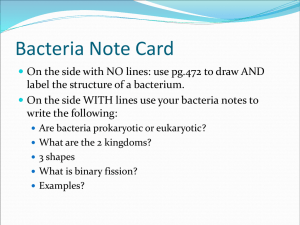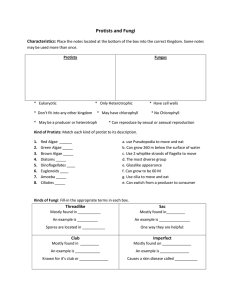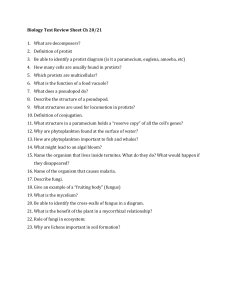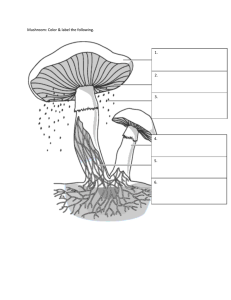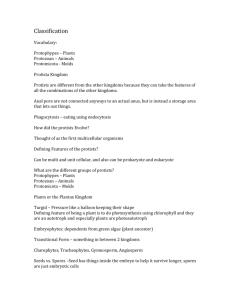Viruses, Bacteria, Protists, and Fungi
advertisement
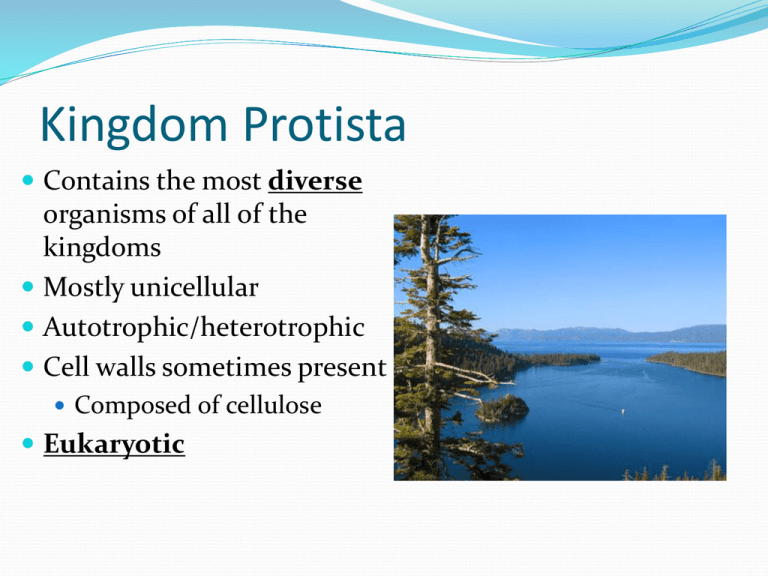
Kingdom Protista Contains the most diverse organisms of all of the kingdoms Mostly unicellular Autotrophic/heterotrophic Cell walls sometimes present Composed of cellulose Eukaryotic Because the Protist Kingdom tends to be a “dumping” ground for organisms that don’t quite fit anywhere else, the organisms in this kingdom tend to closely resemble organisms of the other kingdoms. This is why we group protists as being plant-like, animal-like, and fungus-like. Plant-like Protists Use sunlight to make their food (photosynthetic) Algae Do not have roots, stems, leaves Unicellular Multicellular Major Phyla of Algae: Euglenoids Aquatic, unicellular and multicellular Autotrophic because can photosynthesize Heterotrophic because without the presence of light can ingest food. Diatoms Unicellular and photosynthetic Marine and freshwater Reproduce asexually and sexually Store food as oil rather than starch- gives fish an oily taste. Dinoflagellates Most are live in saltwater environments Thick cell walls Produce toxins which are responsible for fish kills Cause what is known as “red tide” These toxins can infect shellfish that feed on it so harvesting of these shellfish is usually banned during these months to prevent sickness. Red Algae Live in deep water where other seaweeds cannot survive because have pigments that can absorb sunlight at depths greater than 100 m. Brown Algae Float near surface where light is available Form thick, underwater forests that provide a rich underwater ecosystem. Green Algae Most diverse. Most are in fresh water. Asexual and sexual reproduction. Unicellular or multicellular. Animal-like Protists Unicellular heterotrophs Protazoa Grouped according to how they move. Four main groups of protozoans 1. Amoebas (also known as Sarcodines) Form pseudopodia to engulf food particles (endocytosis) as well as for movement. Pseudopodia: cytoplasm extensions that act like “arms” Reproduce through asexual reproduction Amoebas 2. Flagellates Move through use of flagella Flagella: whip-like tails that help a cell move Some act as parasites while some are beneficial Flagellates 3. Ciliates Use cilia for movement Cilia: short thread-like hair that help a cell move. Diverse aquatic habitats Ciliates 4. Sporozoans Produce spores which is a reproductive cell that forms without fertilization and produced a new organism. Internal parasites (ex. Animal blood or intestines) Animal-like Protists and Disease Many protists are disease-causing parasites. Most commonly they cause malaria and African sleeping sickness. Sporozoans and Malaria: Mosquitoes carry the spores of Plasmodium and infect humans as they bite them. The sporozites reproduce asexually in human’s liver, forming spore-like cells that enter the red blood supply and reproduce rapidly. Fungus-like Protists Examples include: Slime-mold Can decompose dead organisms Could move at one point in their life. Kingdom Fungi Mushrooms, mold, yeast Eukaryotic Heterotrophic “Great decomposers” Few unicellular fungi (yeast) Mostly multicellular Fungus Structure Hyphae: the primary structural unit of fungi. Mycelium: A thick mat of hyphae The part you see of a mushroom is the only reproductive structure. Spores form and are released from the gills under the mushroom cap which is how a mushroom reproduces. Adaptations in Fungi Some negative: spoiled food, diseases, poisonous mushrooms Plant Diseases: Fungi can cause diseases such as corn smut which destroys corn kernels. Also can cause wheat rust which affects wheat fields. Human Diseases Athletes foot A fungal infection common on feet Candida Animal Diseases Cordyceps A fungus that attacts certain species of grasshopper in the rain forests of Costa Rica Positives: Decompose large quantities of Earth’s wastes- without fungi there would be large quantities of waste sitting around. Break down complex organic substances into raw materials which living organisms need Lichens A symbiotic relationship between a fungus and a photosynthetic plant such as algae. A symbiotic relationship is when two organisms live in close association with each other. In a lichen, the fungus provides water for the plant to photosynthesize and the plant provides nutrients for the fungus to survive. Mycorrhizae A mutualistic relationship between a fungus and roots of plants. A mutualistic relationship is a type of symbiosis where two organisms benefit from a close relationship. In mycorrhizae, the roots provide nutrients for the fungus and fungus provides water for the roots.
